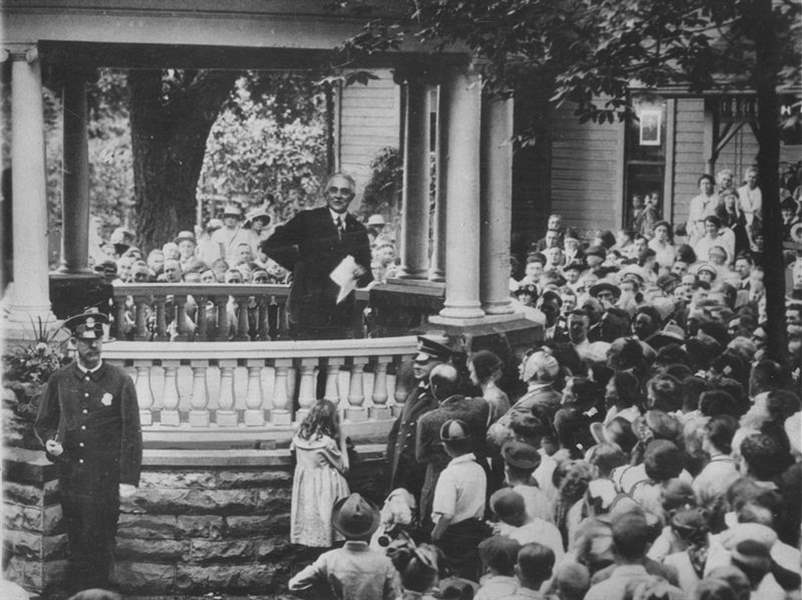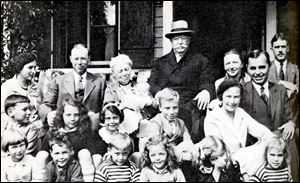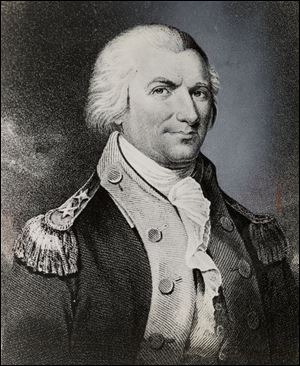
Politicians left imprint on nation
3/2/2003
Warren Harding of Corsica (now Blooming Grove) defeated another Ohio journalist, James Cox of Middletown, in the 1920 presiddential race.
BLADE

Gov. Bob Taft's great-grandfather, former president William Howard Taft, in hat; grandfather, Robert A. Taft , back row, second from left, and father, Robert Taft, Jr., second row, far left, sit for a family portrait in the late 1920s.
Had Arthur St. Clair not been quite such a failure, Ohio as we know it might not exist.
St. Clair, a general in George Washington's revolutionary army, failed miserably as a warrior. Later, he lost a political battle at the hands of President Thomas Jefferson that paved the way to statehood.
Assigned in 1777 by General Washington to defend Fort Ticonderoga on the western shore of Lake Champlain in New York, widely thought to be impregnable, he and his men abandoned it to the British. A dumbfounded Congress recalled him from the field. A decade later, as administrator of Indian affairs in the Northwest Territory, part of which would one day become Ohio, he lost a string of battles against tribes in an enterprise nearly unrivaled in history for its poor planning and execution, according to the Dictionary of American Biography.
Failing in war, he turned to politics. A federalist like Washington, he believed residents of the Northwest Territory were unrefined and unable to govern themselves. As governor of the territory, he battled pro-statehood Democrat Thomas Worthington of Ross County and “objected to statehood as premature and sought to gerrymander the territories into smaller territories so as to postpone statehood indefinitely,” said the dictionary, published in 1946.
When President Jefferson — a Democrat who supported Ohio statehood — took office in 1801 and found General St. Clair working to undermine the state constitutional convention of 1802, he removed him from his post. Again, General St. Clair retreated, this time to his estate in western Pennsylvania, where years earlier he had grown to be a wealthy man of influence. In the end, poor business practices led to the loss of his fortune, and he faded into history, now remembered mostly because of a large lake near Detroit that bears his name.
Even at that, the lake is a minor among greats, and there is some historical question as to whether it was named for him or for Saint Clare of Assisi.
In its first 50 years of statehood, Ohio leaders turned themselves inward to solidify the political footings of the state. Their foundation would eventually support a weighty political heritage almost unmatched in the United States in the number of men it would propel to the White House and in the imprint its leaders would stamp on national history.
In part by geography and in part because of the diverse backgrounds of its people, Ohio remains almost without peer in the role it plays in modern national political campaigns.
Two hundred years have produced myriad stories of Ohio politics, but two facts dominate:

Warren Harding of Corsica (now Blooming Grove) defeated another Ohio journalist, James Cox of Middletown, in the 1920 presiddential race.
Harrison was a 22-year-old Hamilton County soldier when President John Adams appointed him the Northwest Territory's first representative to Congress in 1799. In 1800, he was appointed by Adams to serve as the first governor of the Indiana Territory before returning to Ohio to serve as a state and U.S. senator. He won the presidency in 1840.
Despite inclement weather on March 4, 1841, he delivered an inaugural address on the East steps of the U.S. Capitol that lasted an hour and 45 minutes — the longest on record. Apparently he caught a cold during the day's ceremonies. Unable to regain his health, his presidency — the shortest on record — ended with his death just 32 days later.
His father, Benjamin Harrison, was one of the signers of the Declaration of Independence. His son was a congressman, and his grandson, Benjamin Harrison, also served in the U.S. House on his way to the presidency, establishing the state's first political dynasty, a status unchallenged until the emergence of the Taft family.
Once Ohio reached statehood, its legislature selected three members to Congress, sending Thomas Worthington and John Smith to the U.S. Senate and Jeremiah Morrow to the U.S. House.
Worthington, an architect of the first state constitution, would later find himself severely limited in what he could accomplish after his gubernatorial election in 1814 — because of the dramatic limitations the state charter placed on its chief executive.
Smith's legislative career in Washington was overshadowed by his connection to Aaron Burr, vice president under Jefferson, who presided over the Senate and was later prosecuted for treason. Burr was not convicted, but the scandal was enough to ruin both his career and that of Smith, whose only crime was to befriend Burr, hosting him several times at his Cincinnati home.
Ohio leaders forced Smith to resign his Senate seat amid the Burr treason controversy.
Morrow was elected repeatedly to the House, serving until 1813, when he switched to the U.S. Senate, serving six years there. Accounts show Morrow served ably in Congress, becoming an expert in the government's dealings with the public lands and its sale to citizens. He championed a plan in which the federal government sold off land in smaller, more affordable chunks to frontiersmen.

St. Clair: He tried to block statehood.
The Democratic Party found itself on the rise in Ohio in the early 1800s as the Federalists began to wane. Whigs also gained in power but faded as the nation trudged inevitably toward the Civil War. The Republican Party was established in the 1850s as slavery rose to the top of national issues.
The GOP took its members from disaffected Democrats unhappy with the party's pro-slavery bent and from the Whig Party that was losing steam.
But two factors were quietly at work that changed the state's political landscape. Northeast Ohio, which in its first century was dominated by descendants of New Englanders who identified with the Whigs and Republicans, became the new home of an influx of ethnic Slavs, Italians, Greeks, and Scandinavians, as well as more Germans and Irish, who were attracted by the booming industrialization and urbanization of the region.
The 1910 Census showed that, for the first time since statehood, more Ohioans lived in cities than not. That development would be the key to the second 100 years of political history in Ohio.
As this demographic trend was developing, Ohio put a string of men into the White House, taking advantage of its growing power as the nation struggled with the aftermath of the Civil War and the beginnings of the Industrial Revolution.
Of the eight men claimed as Ohio presidents — William Henry Harrison, Ulysses S. Grant, Rutherford B. Hayes, James A. Garfield, Benjamin Harrison, William McKinley, William Howard Taft, and Warren G. Harding — four died in office. Two — James A. Garfield and William McKinley — were assassinated by gunmen while on trips away from the White House. Garfield's assassin was hanged, while McKinley's fell victim to technology: He died by electrocution.
The last Ohio president elected was Warren G. Harding of Corsica (now Blooming Grove), who defeated another Ohioan — James M. Cox of Middletown. Both Harding and Cox, plus a third presidential candidate in the 1920 race — Robert C. Macauley of Philadelphia — were newspapermen. Despite his roots in print journalism, Harding was the first president to make a radio broadcast to citizens.
Unfortunately, his administration is best known for yet another “first” — his cabinet contained the first member to be convicted of a crime connected to his official duties. Interior Secretary Albert Bacon Fall was convicted of accepting a $100,000 bribe as part of a scheme to steer favorable government oil leases to a certain company.
The Great Depression was a major political force that balanced the partisan influence in the state. The Republican Party lost momentum it had built after the Civil War, and Democrats capitalized on the perception that Republicans under President Hoover — elected to his only term in 1928 — were indifferent to the suffering of those most affected by the historic economic downturn.
Democrats, under the leadership of Franklin D. Roosevelt and his New Deal proposals, became known as the party of the downtrodden, forging a coalition that remains the backbone of the party.
This political realignment was most pronounced across the northern tier of Ohio, where industrialization had taken hold in Toledo, Cleveland, and Youngstown. Those who had been pre-disposed to support the Republican Party switched their loyalties in droves to the Democratic Party.
Since Democrats and Republicans constituted their parties in their modern forms in the 1860s, Ohio voters have shown a tendency to bounce back and forth when choosing their leaders. The longest-serving governor was Republican James A. Rhodes, who was first elected in 1962 and served 16 years, but even his service was interrupted after eight years by a four-year term served by Democrat John J. Gilligan.
Perhaps more than any other state, Ohio became known in the 20th century as a national barometer of national elections. Since 1900, the state mirrored the results in 24 of the 26 presidential elections.
The exceptions came in 1944, when Thomas Dewey narrowly won the state but lost the election to Franklin D. Roosevelt, and in 1960, when Richard Nixon won the state but lost the election to John F. Kennedy.
In the state's first century, from 1804 to 1896, the state outcome was the same as the national outcome in 17 of the 24 presidential elections.
“Ohio has always been literally in the heart of the country, both geographically and as a bellwether for the nation as a whole,” said Dr. Peter Schramm, director of the John Ashbrook Center for Public Affairs at Ashland University. “That reflects something about the character of the state that you can't say about Wyoming or Alabama or certainly not California. We have a moderate flavor, and the state doesn't swing to extremes easily. It is socially stable.”
The state is in the midst of a gubernatorial anomaly, as Republicans will have controlled the state chief executive's office for 16 continuous years when incumbent Bob Taft's term ends in 2007. It represents the longest continuous period of time that one party has held the governor's office since 1822.
John Green, the director of the Ray C. Bliss Center of Applied Politics at the University of Akron, said that Republicans occasionally have dominated, but that Democrats will certainly rebound.